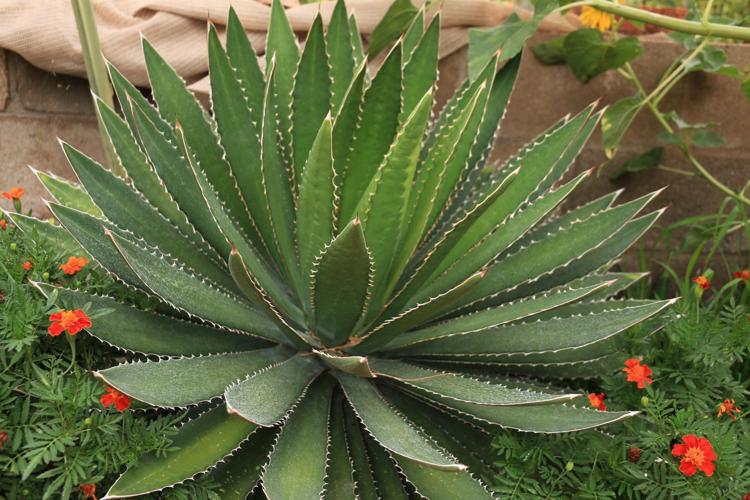Tough love — or maybe benign neglect — has created a colorful, thriving garden at Margaret Hartnett and Darrell Dixon’s Bisbee home.
Theirs is among the 10 stops in the 15th annual Garden Tour put on by the Bisbee Bloomers, coming Aug 27.
The landscape is a study in letting plants grow where they’re happy. The couple has been rewarded with many “babies” that they transplant to other parts of the yard or give as gifts to friends.
While Hartnett’s gardening philosophy leans toward a sense of wildness with cultivated plants, the current landscape is much more tame than when the couple first looked at the house.
When they moved into the historic Warren District in 2002, they faced a fixer-upper of a house and a garden that Hartnett describes as “deep in weeds and broken-down fences. Where the vegetable garden is now was matted with Bermuda grass.”
She admits it took some six years of mixed success growing plants before she took a different tack. “We stood back and said, ‘Let’s see what’s working and what’s not.’”
That’s when they paid attention to the microclimates, the pockets where different growing conditions hold sway.
For instance, they figured out that the front yard gets colder than the backyard by several degrees because of a nearby flood-control canal where cold air collects.
That meant the location didn’t work for the peonies, but it proved to be the right condition for dahlias, which have proliferated from three original bulbs. Hartnett tried growing one in the backyard. “It rotted. I think it was too warm and too moist.”
It was the rose of Sharon that taught Hartnett that Mother Nature knows best.
Planted against an east-facing wall, the bush, also known as Chinese hibiscus, grows white flowers with a maroon center. Over the years it’s dropped seeds that have germinated.
The couple have kept seven of those seedlings that happened to sprout in the right places for their needs. Some of next-generation plants yield flowers of the varieties that were originally combined to create the mother plant, including a lavender with a purple center and an all-white version. Every summer they pull out dozens of seedlings that aren’t in the right place for their liking.
This kind of thing happens all the time, Hartnett says. The roses and the French marigolds easily reseed and grow into maturity. The 10-year-old stately Queen Victoria agave (Agave victoriae-reginae) puts out pups every season.
The roses and marigolds pretty much stay where they are. Harnett has relocated three of the agave pups to other places in the yards and has given several away.
She’s most proud of the volunteer seedlings that have emerged from the mature Afghan pine (Pinus eldarica) that towers over the house. Hartnett put one of them in a pot for a year and, at 4 feet tall, it’s ready to be transplanted to another part of the yard.
Transplanting these babies is a tricky business, she says. “Obviously they like where they sprouted.” More often than not, a transplanted specimen doesn’t survive.
Hartnett hopes her method of tough love gives them a fighting chance. She isn’t willing to baby a seedling — providing it extra water, shade and an otherwise stress-free lifestyle — in order to make it succeed.
“It has to be able to accept all the terms and conditions of your yard,” she says of the young plants. That means they have to survive the temperature, wind, soil, rainfall, snowfall, whatever exists in the spot to which it will be transplanted.
Hartnett does give the plant a head start toward this hardening by letting it grow in its happy spot until it looks viable.
She follows that up by transplanting it in some of the soil it grew in. Then it’s up to the plant, she says.
“You’re either going to make it or you’re not. If I give you too much tender loving care and then try to transplant you, you’re probably not going to make it.”
This benign neglect reveals what the toughest plants are for the couple’s landscapes. Wildflowers are among them.
Hartnett finds that the yard is a magnet for invasive species, especially Mexican feather grass and larkspur. “If I don’t keep some of this stuff under control, it will predominate,” she says, “and that’s not what we’re trying to do here.”
Over the years, Hartnett has learned to let the garden be. It’s an attitude that has worked well for her.
“Nature will tell you want you need to do,” she says. “Sometimes you just need to leave it alone, forget what you want and work with what you have.”








